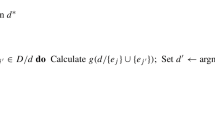Abstract
Since the development of methods for the analysis of experiments with dependent data, see for example Gleeson and Cullis (1987), the design of such experiments has been an area of active research. We investigate the design of factorial experiments, complete and fractional, for various dependency structures. An algorithm for generating optimal or near optimal designs is presented and shown to be useful across a wide range of dependency structures.
Similar content being viewed by others
Explore related subjects
Discover the latest articles, news and stories from top researchers in related subjects.References
Aarts, E. H. L. and van Laarhoven, P. J. M. (1989) Simulated annealing: an introduction. Statist. Neerlandica, 43, 31–52.
Cheng, C.-S. and Steinberg, D. M. (1991) Trend robust two-level factorial designs. Biometrika, 78, 325–36.
Constantine, G. M. (1989) Robust designs for serially correlated observations. Biometrika, 76, 245–51.
Gleeson, A. C. and Cullis, B. R. (1987) Residual maximum like-lihood (REML) estimation of a neighbour model for field experiments. Biometrics, 43, 277–88.
Jansen, J., Douven, R. C. M. H. and van Berkum, E. E. M. (1992) An annealing algorithm for searching optimal block designs. Biom. J., 34, 529–38.
John, J. A. and Whitaker, D. (1993) Construction of resolvable row-column designs using simulated annealing. Austral. J. Statist., 35, 237–45.
Lundy, M. (1985) Applications of the annealing algorithm to combinatorial problems in statistics. Biometrika, 72, 191–98.
Martin, R. J. and Eccleston, J. A. (1992) A new model for slowly-decaying correlations. Statistics & Probability Letters, 13, 139–45.
Martin, R. J., Eccleston, J. A. and Jones (1998) Some results on multilevel factorial designs with dependent observations. J. Statist. Plann. Inference, in press.
Martin, R. J., Jones, G. and Eccleston, J. A. (1997) Some results on two-level factorial designs with dependent observations. J. Statist. Plann. Inference., 66, 363–384.
Martin, R. J., Jones, G. and Eccleston, J. A. (1998) Eight-run two-level factorial designs under dependence. Metrika, (to appear).
Metropolis, N., Rosenbluth, A., Rosenbluth, M., Teller, A. and Teller, E. (1953) Equation of state calculation by fast com-puting machines. Journal of Chemical Physics, 21, 1087–92.
Russell, K. G. and Eccleston, J. (1987) The construction of op-timal incomplete block designs when observations within a block are correlated. Austral. J. Statist., 29, 293–302.
Saunders, I. W. and Eccleston J. A. (1992) Experimental design for continuous processes. Austral. J. Statist., 34, 77–89.
Saunders, I. W., Eccleston, J. A. and Martin, R. J. (1995) An algorithm for the design of 2p factorial experiments on con-tinuous processes. Austral. J. Statist., 37, 353–65.
Venables, W. N. and Eccleston, J. A. (1993) Randomized search strategies for finding optimal or near optimal block and row-column designs. Austral. J. Statist., 35, 371–82.
Williams, E. R. (1985) A criterion for the construction of op-timal neighbour designs. J. Royal Statist. Soc. Series B, 47, 489–97.
Rights and permissions
About this article
Cite this article
Elliott, L.J., Eccleston, J.A. & Martin, R.J. An algorithm for the design of factorial experiments when the data are correlated. Statistics and Computing 9, 195–201 (1999). https://doi.org/10.1023/A:1008965829964
Issue Date:
DOI: https://doi.org/10.1023/A:1008965829964




